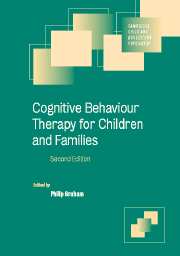Book contents
- Frontmatter
- Contents
- List of contributors
- 1 Introduction
- Part I Developmental cognitive theory and clinical practice
- Part II Engagement and assessment
- Part III Client groups
- Part IV Applications in psychosocial adversity
- Part V Applications in specific child and adolescent psychiatric disorders
- Part VI CBT applications in preventive interventions
- 27 The prevention of conduct problems
- Index
- References
27 - The prevention of conduct problems
Published online by Cambridge University Press: 21 August 2009
- Frontmatter
- Contents
- List of contributors
- 1 Introduction
- Part I Developmental cognitive theory and clinical practice
- Part II Engagement and assessment
- Part III Client groups
- Part IV Applications in psychosocial adversity
- Part V Applications in specific child and adolescent psychiatric disorders
- Part VI CBT applications in preventive interventions
- 27 The prevention of conduct problems
- Index
- References
Summary
Conduct problems in children constitute a broad spectrum of ‘acting-out’ behaviours, ranging from relatively minor oppositional behaviours such as yelling and temper tantrums to more serious forms of antisocial behaviour such as aggression, physical destructiveness and stealing. These behaviours typically co-occur as a complex or syndrome, and there is strong evidence to suggest that oppositional behaviours (e.g. non-compliance) are developmental precursors to more serious antisocial behaviour. In this chapter, the term ‘conduct problems’ (CP) is used to refer to this constellation of behaviours. The authors' conceptualization of CP is consistent with, but not isomorphic with, the Diagnostic and Statistical Manual of Mental Disorders-IV (American Psychiatric Association, 2000) diagnostic categories of oppositional defiant disorder and conduct disorder.
The early starter developmental pathway for serious CP
The prevention of CP has received increasing interest and attention over the past 10 years. This has been partly due to advances made in the delineation of developmental pathways of CP and the risk and protective factors associated with progression on this pathway. Identification of such pathways and associated risk and protective factors can provide guidance for interventions with developmental precursors (e.g. oppositional behaviour) that may be more amenable to change.
The pathway with the most negative long-term prognosis, and which is the most salient for prevention, has been referred to as the ‘early starter’ (Patterson et al., 1991) or ‘life-course persistent’ (Moffitt, 1993) pathway.
- Type
- Chapter
- Information
- Cognitive Behaviour Therapy for Children and Families , pp. 481 - 504Publisher: Cambridge University PressPrint publication year: 2004
References
- 1
- Cited by



